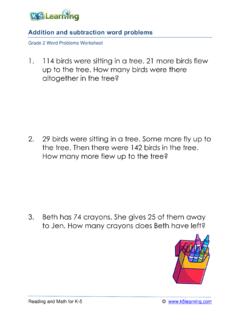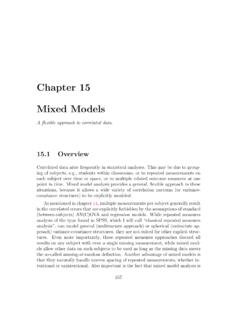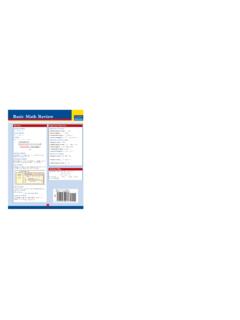Transcription of Challenges in Mixed Ability Classes and Strategies ...
1 English Language Teaching; Vol. 10, No. 6; 2017. ISSN 1916-4742 E-ISSN 1916-4750. Published by Canadian Center of Science and Education Challenges in Mixed Ability Classes and Strategies Utilized by ELI. Teachers to Cope with Them Muneerah S. Al-Subaiei1. 1. English Language Institute, King Abdul Aziz University, Kingdom of Saudi Arabia Correspondence: Muneerah S. Al-Subaiei, English Language Institute, King Abdul Aziz University, Kingdom of Saudi Arabia. E-mail: Received: March 1, 2017 Accepted: May 22, 2017 Online Published: May 29, 2017. doi: URL: Abstract Mixed - Ability Classes have been found to be one of the greatest detriments to students learning at English language institutions (ELIs). There has been a growing concern over the impacts of the Mixed - Ability Classes calling for a study aimed at suggesting solutions for this situation.
2 This study involves thirty-three female EFL. teachers who work in an English language institute (ELI) and their feedback was obtained via questionnaires which were distributed online. The questionnaires addressed this issue on various levels following categories such as teaching and learning, materials, motivation and class management practices. The results indicated that the frequency of the cases of Challenges in the teaching of Mixed - Ability Classes was high and thus requiring appropriate solutions. Class management and differentiation Strategies were found to be the most effective in mitigating the adverse effects which Mixed -learning abilities have on learning successes. The effectiveness of the Strategies used had no relation whatsoever to the level of experience of the teachers.
3 Strategies that seem to work best were those that focused on the students or what is referred to as student-centered approach. Keywords: Mixed - Ability Classes , Strategies , Challenges , English Language Institute (ELI), Saudi Arabia 1. Introduction Among the many Challenges facing teaching instructors today is the Mixed - Ability class. According to Chapman and King (2003), a Mixed - Ability classroom consists of a group of students with differing levels of learning abilities, interest, and skills. EFL teachers have grown to identify this as one of the greatest aspects that invariably determines the level of teaching and understanding of what the students undergo in the long run. In support of this, Hedge (2000) noted that teaching a classroom of Mixed - Ability students is a vital and genuine issue that instructors experienced daily.
4 He also went on to reckon that the Mixed - Ability problem demanded serious attention from experts in the educational field. While each learner has their own unique way of learning English coupled with different linguistic knowledge and the individual pace of learning; there seems to be an overarching need for the instructor to apply methods that would engage all the students in the same measure. This is especially because a dilemma normally arises for the instructor on who to concentrate on. Should they concentrate on the advanced learners and neglect the weaker ones? The converse of this would also be disadvantageous to the advanced learners, since they will not be able to participate based on their true potential.
5 Following this situation, this study attempts to explore the Challenges of Mixed - Ability Classes and Strategies that are utilized by EFL teachers to overcome these matters. 2. Literature Review Mixed - Ability Classes generally refer to Classes where learners have a broad range of levels in their achievement and learning. The students in these Classes differ in strengths and weaknesses and have different approaches to learning. Different scholars have defined this topic in many ways using the different perspectives gained from different learning environments. Ansari (2013) for instance describes a Mixed - Ability class as comprising of not only learners with various capacities but also those that have a broad range of preferences and learning styles.
6 They can also be referred to as a variation of students in their abilities in grammatical knowledge, fluency and accuracy, size of vocabulary, receptive and productive skills (Valentic, 2005). Notably, there are many factors which may differ from one student to another such as their attitude, motivation, and self-discipline (Lightbown & Spada, 2006). This makes it difficult for the teachers to effectively plan for 182. English Language Teaching Vol. 10, No. 6; 2017. their lessons to ensure that all their students reap the required benefits from the lesson. This is especially a challenge for the language instructors who are not equipped with the required skills and teaching methods to deal with Mixed - Ability Classes (Ansari, 2103).
7 Most institutions have sorted to address this problem by dividing the Classes according to their ages. But these Classes are still multileveled since it is still deemed random when individual abilities are considered. Studies have shown that random grouping does not incorporate the level of Ability and attainment skills of individual students. This results in various Challenges to the teachers who try to give equal opportunities for learning to all the students in the class (Boaler, 2008). However, there are advantages associated with teaching in Mixed - Ability Classes even though they are often overshadowed by the Challenges . These Classes provide interesting learning environments because they are composed of a rich pool of diverse skills, dispositions and perspectives.
8 Most importantly, the interactions in these Classes enable the students to be more creative and innovative as they learn from each other's unique abilities. However, the difficulties faced by language instructors in Mixed - Ability Classes are often numerous and invariably lead to frustrations on their part since they are unable to create a productive learning and teaching environment for their students. Ireson & Hallam (2001) suggest that instructors need to recognize that a class is of Mixed - Ability because learners have different strengths and weaknesses and improve at different rates. Consequently, instructors in regular classrooms are always put under intense pressure to address the needs of their diverse learners (Mayer, 2008).
9 Teachers are also faced with the shortage of training programs and Strategies to prepare them for such situations at the workplace. These Strategies have been floated to be very crucial and instrumental in ensuring there is success in the learning experiences of the students. The fact of the matter is that most instructors lack the professional development, planning time, or the capacity to consistently implement differentiation (Loiacono &. Allen, 2008). Instructors in Mixed - Ability classrooms need to be afforded continuous training to better manage the Challenges of their diverse learners (Butterworth, 2010). Most Classes are comprised of a large number of students, and it is the responsibility of the teacher to control the students and to deliver the lesson effectively.
10 Since the responsibility of taking care of the individual needs of each student lies on the shoulder of a single teacher, it has become a very tedious process. It has become difficult to administer their lesson plans in a Mixed - Ability class since every student has a different level of understanding (Northcote 2006). A good example is seen when a teacher is explaining a concept in class. The students with a high- Ability of understanding get bored as the instructor tries to make further explanations to the students with moderate to low levels of knowledge absorbing capabilities. The most challenging part of English language teaching in a Mixed - Ability class is the fact that the teachers are expected to guide students at their individual pace, regardless of the proficiency differences.

















